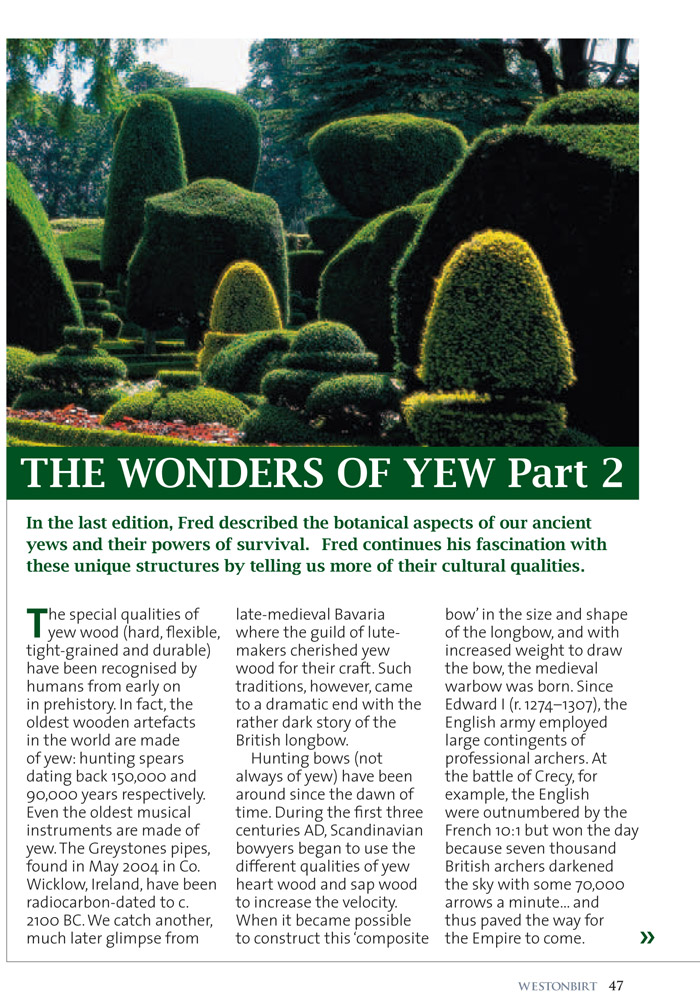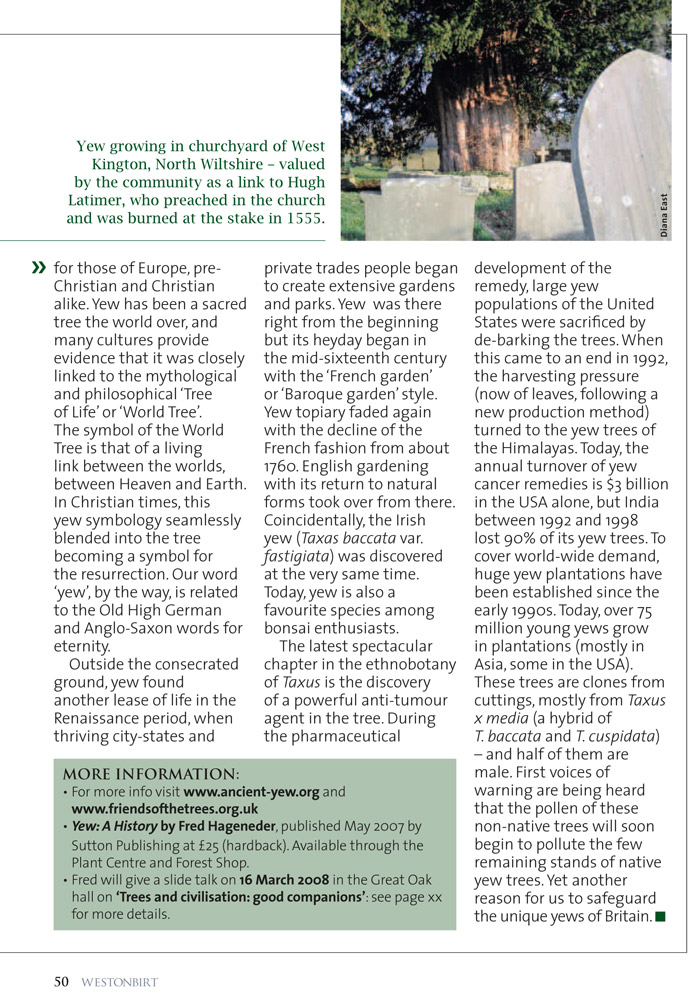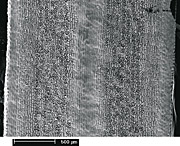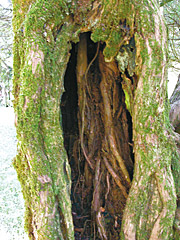Las maravillas del Tejo
The Wonders of Yew
(Las maravillas del Tejo)
Artículo de Fred Hageneder en Holfordiana,
la revista oficial del National Arboretum de Westonbirt, UK
(en inglés)
Part I: Botany (winter 2007)Perhaps no tree other than Taxus baccata L., the yew, has kept us guessing so much and for so long. First, there’s the taxonomy. Being a ‚conifer‘ that refrains from producing cones and instead lets a sweet succulent red aril develop around the seed. ‚Baccata‘ means berry-like. image: red aril in winter. © Christian Wolf Next, there is no agreement among botanists whether the yews of the world (which occur naturally all around the northern hemisphere) are to be seen as mere subspecies of the European Yew or if they are a species proper. But one thing is for sure: as the genus has a proven history of 15 million years, and may even date back to the Jurassic period, Taxus baccata is the oldest native tree species of Europe. However, the yew question that has kept British dendrologists and tree enthusiasts busy ever since the relationship of annual rings to the age of a woody plant was discovered in the 1830s is that of old age: "Can they really live that long?‘ While we know of ‚thousand year old‘ oak trees, the majority struggle to get past 600, so can it be that yews dare to be older? The answers swing like a pendulum. Because the Victorians were guilty of hopelessly overestimating the age of any yew tree, the tide turned to a dramatic underestimation at the beginning of the 20th century. Today, however, we have increasing dendrochronological evidence that yew trees can indeed live far longer than a millennium. In fact, old age and extreme slow growth are integral parts of the survival strategy of this species.
Safety tricks for a long lifeIn our part of the world, yew is a climax woodland species that occurs naturally as scattered individuals or in groups or clusters in mixed oak or beech woodland, its most frequent companions in the under-storey are holly, box, hazel and hawthorn. The ecological strategy of yew has been dubbed ’saving for safety‘. Where other trees under the forest canopy invest in height increase even when it jeopardises the development of the root system and makes the tree unstable, yew even under poor light conditions invests predominantly in the root system, which provides not only a firm anchorage in the ground but also gives access to new resources. The list of yew’s safety mechanisms also includes the effective storage of resources, the toxicity and high resistance of its organs, the low photosynthesis performance, the extraordinary fastness of stomatal response and last but not least the creation of interior roots in hollowing trunks and the immense potential for regeneration. image: Root system of a wild yew at Merdon Castle, Hampshire. © Tim Hills Yew is known for its shade tolerance, even in an under-storey with less than 5 per cent of the light in the open, yew is still able to produce flowers and seeds. Indeed, its seedlings can grow with less light than the shadow plants that cover the forest ground. Although Taxus is unable to make full use of sunlight in the open, it can photosynthesise throughout the winter (up to -8°C) which is why it prefers broadleaves as neighbours rather than evergreens. But beware! Gardeners need to be aware that yew trees have different types of leaves for high light exposure and for shadow. The sudden exposure of a previously fully shaded yew tree could even kill it because it will need years to change its leaves. image: The bands of stomata on the lower surface of the yew leaf. © Frank Depoix Among the vast potential for regeneration is Taxus‘ ability to produce adventitious shoots from anywhere beneath the bark. If a tree should fall, (be severely pruned) such shoots can even grow into (a row of) new stems – an image of overflowing vitality otherwise only associated with willows. I have a photo of yews at Westonbirt shorn of all branches and top taken out, regrowth all up the sides.Yew is also capable of branch layering, i.e. lower branches arch down to the ground, take root and produce adventitious shoots some of which may over time develop into stately ’new‘ trees, whether still connected to the parent tree or not. Hence a single tree can form an entire grove. The most astonishing feature, however, is that of interior roots. As the trunk of an old to ancient yew hollows out (with the help of fungi), the cambium produces roots that grow from the top of the trunk all the way down. Over centuries, such an interior root can develop into a new trunk that increasingly takes over the crown of the tree while the hollow shell of the original trunk begins to drop away. Thus the tree can renew itself from the inside out. Needless to say, these phenomena render useless all efforts of dendrochronology to precisely age an individual tree. Unless there is a known planting date for a tree, our intellect, for once, has to succumb. images: Interior roots in Sardegna and in Turkey. © Fred Hageneder As for the vegetative reproduction of yew, this too is wondrous. Taxus baccata is regarded as dioecious, but though some monoecious trees exist, and various trees have been observed to even swap their gender! However, the tree flowers in early spring and the male produces an abundance of pollen. The female flower ensures its pollination by producing a so-called micropylar drop that can catch over 1,000 pollen grains – 250 times the necessary amount. Safety again. Generally, 100 per cent of the female flowers are pollinated and fertilisation occurs six to eight weeks after pollination. When the seeds are ripe in late summer, and all through the winter, the surrounding red arils are highly attractive to birds, primarily starling and various thrushes (particularly song thrush and blackbird). They eat the red, sweet and nutritious flesh, the only part of the tree that is not poisonous, and excrete the seeds, thus being the main agents of distribution. Badgers and foxes do their bit by doing the same with fallen arils. image: Female yew flower with micropylar drop. © Christian Wolf All in all, yew proves to be not a relict of a bygone age but a very vital part of the present. Its world-wide disappearance in the wild is not the result of it supposedly being weak in ecological ‚competition‘ but solely due to global deforestation and other man-made influences. The world-wide destruction of seedlings and saplings, by deer browsing for example, is the result of man’s unwillingness to co-exist with predators like the lynx, the bear and particularly the wolf, naturally the greatest allies of trees. image: Seedlings in winter. © Hubert Roessner The high adaptability of yew is a result of its large genetic variety, which makes possible its survival in the most diverse ecological conditions. The extremely advanced age that yew can reach means that a yew population can ‚wait‘ for long periods of time, until it is ready to rejuvenate in especially favourable periods. But as we have seen it is not only the unique genetic structures of the ancient yew trees of Britain that make them – well, outstanding features of our planet! This is why the Ancient Yew Group and I campaign for the recognition of Britain’s ancient yew trees to be protected as World Heritage or ‚Green Monuments‘. |
|
______
Part II: Cultural History (spring 2008)
(Reiner Text steht unter diesen Seitenabbildungen.)




The special qualities of yew wood (hard, flexible, tight-grained and durable) have been recognised by humans from early on in prehistory. In fact, the oldest wooden artefacts in the world are made of yew: hunting spears dating back 150,000 and 90,000 years respectively. Even the oldest musical instruments are made of yew. The Greystones pipes, found in May 2004 in Co. Wicklow, Ireland, have been radiocarbon-dated to c. 2100 BC. We catch another, much later glimpse from late-medieval Bavaria where the guild of lute-makers cherished yew wood for their craft. Such traditions, however, came to a dramatic end with the rather dark story of the British longbow.
Hunting bows (not always of yew) have been around since the dawn of time. During the first three centuries AD, Scandinavian bowyers began to use the different qualities of yew heart wood and sap wood to increase the velocity. When it became possible to construct this ‚composite bow‘ in the size and shape of the longbow, and with increased weight to draw the bow, the medieval warbow was born. Since Edward I (r. 1274–1307), the English army employed large contingents of professional archers. At the battle of Crecy, for example, the English were outnumbered by the French 10:1 but won the day because seven thousand British archers darkened the sky with some 70,000 arrows a minute … and thus paved the way for the Empire to come.
But the price was high. Britain soon ran out of suitable yew timber. Already in the early 14th century, yew staves for bows were imported from Ireland and Spain, and increasingly from the whole Continent. The Statute of Westminster of 1472 decreed that four yew bow staves had to be imported with every ton of merchandise unloading in any English harbour. A flourishing trade began to develop right across Europe, particularly in the Alps and as far away as the Carpathian mountains. A large-scale ecological disaster was on its way and by the late 16th century yew had been made extinct in large regions of Europe. Elisabeth I had to replace the army’s longbows with (what were still at that time far inferior) shotguns. But the yew populations never recovered. And it is why on the Continent we know hardly more than 20 yew trees of over 20 feet girth, while in England and Wales we can boast some 440 of that size. This makes Britain the last ‚Ark‘ for populations of ancient yews – the only other yew stands of considerable size and age being located in northern Turkey and the Caucasus Mountains in Georgia and southwestern Russia.
But preserving what we have is not an easy thing. Germany and Austria, for example, have taken the path of putting yew (Taxus baccata) on the Red List, which makes it illegal to fell any yew of any age. While this protects the very few ancient specimens in those countries, it inhibits foresters from planting yew trees because they would never be allowed to harvest them. This creates the paradox of a protection plan that contributes to the disappearance of the species from the forests! On the other hand, in Britain (like Switzerland) there are no such regulations covering the growing and felling of yews on both public and private land. Here we can see yew growing in many situations and in every condition: free-growing, trimmed, badly mutilated, harvested or peacefully growing (very) old. But the downside is that there is no legal protection for the most ancient trees of Europe. If the individual landowner or organisation responsible for their protection don’t like yew trees, or understand the significance of an ancient specimen, there is nothing there to stop them destroying these trees.
Apart from the actual groves of ancient yews (such as Druids Grove in Surrey or Kingley Vale in West Sussex) the majority of ancient yews are located in churchyards. Many local communities are aware that the yew growing on their ‚God’s Acre‘ is a national ecological treasure and take measures to ensure that the tree is properly looked after. But there are many that do not and it is time for church authorities to draw up a policy that properly protects this national asset – which brings us back to history once more. "Why are they in churchyards" is the yew question most frequently asked. Contrary to common belief, it has nothing to do with the medieval warbows. All the churchyards in Britain could not have supplied a fiftieth (!) of the army’s demand in bow staves. It should be no surprise that the presence of yew in churchyards and graveyards is not for military but for religious reasons. All around the northern hemisphere, i.e. within the natural distribution zone of this species, yew has been deeply rooted in mankind’s religious customs, particularly those concerning death and the afterlife. This is true for Native American cultures, for ancient and present Japanese traditions and for those of Europe, pre-Christian and Christian alike. Yew has been a sacred tree the world over, and many cultures provide evidence that it was closely linked to the mythological and philosophical ‚Tree of Life‘ or ‚World Tree‘. The symbol of the World Tree is that of a living link between the worlds, between Heaven and Earth. In Christian times, this yew symbology seamlessly blended into the tree becoming a symbol for the resurrection. Our word ‚yew‘, by the way, is related to the Old High German and Anglo-Saxon words for eternity.
Outside the consecrated ground, yew found another lease of life in the Renaissance period, when thriving city-states and private tradespeople began to create extensive gardens and parks. Taxus baccata was there right from the beginning but its heyday began in the mid-sixteenth century with the ‚French garden‘ or ‚Baroque garden‘ style. Yew topiary faded again with the decline of the French fashion from about 1760. English gardening with its return to natural forms took over from there. Coincidentally, the Irish yew (Taxus baccata var. fastigiata) was discovered at the very same time. Today, yew is also a favourite species among bonsai enthusiasts.
The latest spectacular chapter in the ethnobotany of Taxus is the discovery of a powerful anti-tumor agent in the tree. During the pharmaceutical development of the remedy, large yew populations of the United States were sacrificed by de-barking the trees. When this came to an end in 1992, the harvesting pressure (now of leaves, following a new production method) turned to the yew trees of the Himalayas. Today, the annual turnover of yew cancer remedies is $3 billion in the USA alone, but India between 1992 and 1998 lost 90% of its yew trees. To cover world-wide demand, huge yew plantations have been established since the early 1990s. Today, over 75 million young yews grow in plantations (mostly in Asia, some in the USA). These trees are clones from cuttings, mostly from Taxus x media (a hybrid of T. baccata and T. cuspidata) – and half of them are male. First voices of warning are being heard that the pollen of these non-native trees will soon begin to pollute the few remaining stands of native yew trees. Yet another reason for us to safeguard the unique yews of Britain.
_____






